|
 |
Dr Beverly Daniel Tatum
12 August 2013 |
Dr Beverly Tatum lecture (pdf)
Photo Gallery
The United States have much to learn from South Africa about reconciliation. This is according to Dr Beverly Daniel Tatum, president of Spelman College, the oldest college for African American women in the US. Delivering the Second Annual Reconciliation Lecture on our Bloemfontein Campus, Dr Tatum –an internationally-acclaimed educator and expert on race relations –said five years after the US elected its first black president, the country still finds it difficult to make peace with the painful truth of its past.
Drawing inspiration from a speech made by former president Nelson Mandela at the adoption of the South African constitution in 1996, Dr Tatum said it requires courage to engage in a meaningful way with those we have been socialised to mistrust.
Dr Tatum highlighted the shooting of the US teenager Trayvon Martin, who was killed in Florida in an incident many attributed to racial profiling. The unarmed Martin, while out walking in the evening to buy a snack, was accosted and shot by neighbourhood watchman George Zimmerman who suspected him to be a potential thief.
“How do we move beyond stereotypes to more authentic knowledge of one another?” she posed the question to a packed Reitz Hall in the Centenary Complex.
Dr Tatum, author of the critically-acclaimed books, Can We Talk about Race? and Why Are All the Black Kids Sitting Together in the Cafeteria? said we have to be brave enough to have our assumptions challenged.
“If we want a better society, one characterised by strength, trust and unity, we must interrupt the cycle and there is no better place to do it than at a university like this one, where the next generation of leaders is being prepared. But it requires intentionality. It takes practice.”
During her two-day visit, she also met with postgraduate students from the Faculty of Education to discuss social cohesion at schools. She also took part in a roundtable discussion with educators from the UFS and other universities, deliberating the topicLeading with/for/against differences on university campuses.